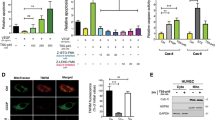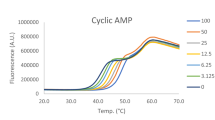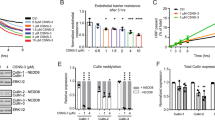Abstract
Increased expression of vascular cell adhesion molecule 1 (VCAM1) is associated with a variety of chronic inflammatory conditions, making its expression and function a target for therapeutic intervention1,2,3. We have recently identified CAM741, a derivative of a fungus-derived cyclopeptolide that acts as a selective inhibitor of VCAM1 synthesis in endothelial cells. Here we show that the compound represses the biosynthesis of VCAM1 in cells by blocking the process of cotranslational translocation, which is dependent on the signal peptide of VCAM1. CAM741 does not inhibit targeting of the VCAM1 nascent chains to the translocon channel but prevents translocation to the luminal side of the endoplasmic reticulum (ER), through a process that involves the translocon component Sec61β. Consequently, the VCAM1 precursor protein is synthesized towards the cytosolic compartment of the cells, where it is degraded. Our results indicate that the inhibition of cotranslational translocation with low-molecular-mass compounds, using specificity conferred by signal peptides, can modulate the biosynthesis of certain secreted and/or membrane proteins. In addition, they highlight cotranslational translocation at the ER membrane as a potential target for drug discovery.
This is a preview of subscription content, access via your institution
Access options
Subscribe to this journal
Receive 51 print issues and online access
$199.00 per year
only $3.90 per issue
Buy this article
- Purchase on Springer Link
- Instant access to full article PDF
Prices may be subject to local taxes which are calculated during checkout





Similar content being viewed by others
References
Springer, T. A. Traffic signals on endothelium for lymphocyte recirculation and leukocyte emigration. Annu. Rev. Physiol. 57, 827–872 (1995)
Schreiner, E. P., Oberhauser, B. & Foster, C. A. Inhibitors of vascular cell adhesion molecule-1 expression. Expert Opin. Therapeut. Patents 13, 149–166 (2003)
Bevilacqua, M. P., Nelson, R. M., Mannori, G. & Cecconi, O. Endothelial-leukocyte adhesion molecules in human disease. Annu. Rev. Med. 45, 361–378 (1994)
Boger, D. L., Keim, H., Oberhauser, B., Schreiner, E. P. & Foster, C. A. Total synthesis of HUN-7293. J. Am. Chem. Soc. 121, 6197–6205 (1999)
Hommel, U. et al. The 3D-structure of a natural inhibitor of cell adhesion molecule expression. FEBS Lett. 379, 69–73 (1996)
Walter, P. & Johnson, A. E. Signal sequence recognition and protein targeting to the endoplasmic reticulum membrane. Annu. Rev. Cell Biol. 10, 87–119 (1994)
Matlack, K. E., Mothes, W. & Rapoport, T. A. Protein translocation: tunnel vision. Cell 92, 381–390 (1998)
Johnson, A. E. & van Waes, M. A. The translocon: a dynamic gateway at the ER membrane. Annu. Rev. Cell Dev. Biol. 15, 799–842 (1999)
Jungnickel, B. & Rapoport, T. A. A posttargeting signal sequence recognition event in the endoplasmic reticulum membrane. Cell 82, 261–270 (1995)
Kim, S. J., Mitra, D., Salerno, J. R. & Hegde, R. S. Signal sequences control gating of the protein translocation channel in a substrate-specific manner. Dev. Cell 2, 207–217 (2002)
Rutkowski, D. T., Lingappa, V. R. & Hegde, R. S. Substrate-specific regulation of the ribosome–translocon junction by N-terminal signal sequences. Proc. Natl Acad. Sci. USA 98, 7823–7828 (2001)
Fons, R. D., Bogert, B. A. & Hegde, R. S. Substrate-specific function of the translocon-associated protein complex during translocation across the ER membrane. J. Cell Biol. 160, 529–539 (2003)
Mothes, W., Prehn, S. & Rapoport, T. A. Systematic probing of the environment of a translocating secretory protein during translocation through the ER membrane. EMBO J. 13, 3973–3982 (1994)
Kalies, K. U., Rapoport, T. A. & Hartmann, E. The beta subunit of the Sec61 complex facilitates cotranslational protein transport and interacts with the signal peptidase during translocation. J. Cell Biol. 141, 887–894 (1998)
DeMartino, G. N. & Slaughter, C. A. The proteasome, a novel protease regulated by multiple mechanisms. J. Biol. Chem. 274, 22123–22126 (1999)
Acknowledgements
We thank A. Rot for generation of the Sec61β antiserum, H. Jaksche for its purification, and B. Kappel, H. Pertl, L. Hofer and N. Lettner for technical assistance.
Author information
Authors and Affiliations
Corresponding author
Ethics declarations
Competing interests
H.H., S.W., C.A.F., E.P.S., B.O., J.E.d.V. and I.J.D.L. are employed by Novartis. In addition, B.O., J.E.d.V. and I.J.D.L. own restricted stocks. J.B., K.M. and C.D.-N. left Novartis and do not have any conflicting financial interests.
Supplementary information
Supplementary Data
Data demonstrating that the VCAM-1 SP plus the first amino acid of the VCAM-1 mature region are required for full sensitivity to CAM741, while parts of the N-terminal region of the VCAM-1 SP are dispensable for translocation and sensitivity. (DOC 24 kb)
Supplementary Figure S1
In vitro translocation experiments described in Supplementary Data. (PDF 225 kb)
Supplementary Table S1
Results from transient transfection experiments described in Supplementary Data. (DOC 32 kb)
Supplementary Methods
Methods for experiment shown in Supplementary Table S1. (DOC 19 kb)
Rights and permissions
About this article
Cite this article
Besemer, J., Harant, H., Wang, S. et al. Selective inhibition of cotranslational translocation of vascular cell adhesion molecule 1. Nature 436, 290–293 (2005). https://doi.org/10.1038/nature03670
Received:
Accepted:
Issue Date:
DOI: https://doi.org/10.1038/nature03670
This article is cited by
-
A common mechanism of Sec61 translocon inhibition by small molecules
Nature Chemical Biology (2023)
-
The role of RNF149 in the pre-emptive quality control substrate ubiquitination
Communications Biology (2023)
-
Ipomoeassin-F disrupts multiple aspects of secretory protein biogenesis
Scientific Reports (2021)
-
Inhibitors of protein translocation across membranes of the secretory pathway: novel antimicrobial and anticancer agents
Cellular and Molecular Life Sciences (2018)
-
Coibamide A, a natural lariat depsipeptide, inhibits VEGFA/VEGFR2 expression and suppresses tumor growth in glioblastoma xenografts
Investigational New Drugs (2016)
Comments
By submitting a comment you agree to abide by our Terms and Community Guidelines. If you find something abusive or that does not comply with our terms or guidelines please flag it as inappropriate.



